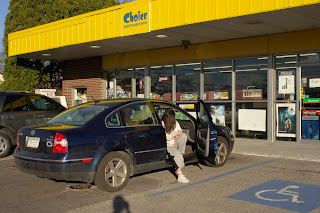Paragraphs Stanley
Sally Mann was introduced to photography at a young age by her father. She began using his 5 x 7 camera which she has consistently used throughout her career. What makes the image hers is her ability to use various techniques and photographic elements in order to convey a single idea.
Throughout “Proud Flesh” the images have a decent bit of variety but certain elements remain constant. Some of the consistent elements in her photos is using black and white and using natural light. Her images take place in doors in extremely dim areas, with the only light seeming to come from sunlight peeking in windows and doorways. Her relationship to her subject is extremely important in understanding what she is going for in this work. In “Proud Flesh” she photographs nude subjects, which isn’t a new concept in photography or in art in general however. What separates her images and makes it completely her own, is the decision to photograph subjects which aren’t models in any traditional sense. The subjects range from over to underweight, and their skin is scarred and wrinkled. Here Mann wants to display the beauty in the imperfection of her subjects (at least from what I can gather). Adding on to the effect of flawed and beautiful, the images are scratched which reflect the scars, the images are withered to reflect the aging of the subjects present.
Pierre Crocquet De Rosemond was born in Cape Town, South Africa, from there he moved and was raised in the town of Klerksdorp. He majored in financing and became an accountant. Klerksdorp is a poor mining city outside of Johannesburg. He traveled throughout the world after studying, doing work which he considered deeply unsatisfying. Upon realizing this career was not for him, he returned to school and majored in photography. Throughout his entire work he displays subjects who have received or experienced some sort of injustice, ranging from those who suffer from extreme poverty to victims of sexual assault. Rosemond states he rarely plans his shoots, which gives all his images a consistent feeling of authenticity and a raw aspect to them. He uses a "Pentax Spotmatic SPII" camera He uses cheap film in order to achieve a grainy feel which he believes his unparalleled.
In his work "Enter Exit" Rosemond displays the racially diverse but uniformally impoverished area. What makes the his own is presenting his subjects throughout their daily life, in a way that comes across largely un-staged and natural, focusing on the subject and what their environment says about them. He photographs his subjects with great dignity and respect, regardless of their environment. All images are displayed in black and white.
Santiago Torralba is the most elusive of all 3 of the photographers I have chosen, even with Google Translate on my side finding information about him outside of his recent exhibits is quite the challenge. Torralba began his photography career when he was 18 when he was invited to an photo lab by his friend. He majored in Fine Arts, which makes sense considering how aesthetically appealing his images are He claims that he has no influence in terms of photographers that have influenced him. He carries around a camera wherever he goes. He doesn’t believer that he is an artist, but rather a worker.
Geometries was achieved by Torralba journeying around barren landscapes in Mexico. Throughout the work Torralba locates man-made , whether it be finished or unfinished, and photographs them, saying he values what is infrequently looked at and are often lost in the horizon. Although each photo displays a man made creation, there is no evidence of human existence (no people, cars, or lights), which gives it an almost apocalyptic feeling to it. All the images are very geometric, with sharp lines and symmetry. I personally feel his intention was to take man made items and de-contectualize the item in order for the viewer to appreciate it, just enough is shown, however enough is kept away where what the building/object/garage/wire is used for, it simply exists and it is a thing of beauty. The only context that is given is scenic area around the object, which consists of blue skies and mountainous terrain, and the juxtaposition between the manmade object and the nature it disrupts I feel is of importance to him.



Comments
Post a Comment